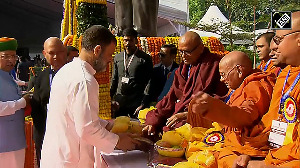International relations are full of paradoxes. But there's something about Nathu-la that brings them home afresh.
For years, the paradox was epitomised by Indian tourists in Sikkim shaking hands and posing for photographs with Chinese soldiers, even as our jawans stood locked in eye-to-eye combat with the latter.
And now, the time is ripe for paradoxes again as this mountain pass, 14,500 feet above sea level and 54 km from Gangtok, is to be re-opened for trade between India and Tibet on July 6, 44 years after it was closed down following the 1962 India-China war -- and three years after the memorandum on expanding border trade was signed by A B Vajpayee in 2003.
Work on both sides is on in full swing to ready the road, the sheds, and the podium where the re-opening ceremony is to take place before a gathering of regional and central government officials of both sides; the chairman of the Tibet Autonomous Region is also expected to attend.
On the Indian side, the last 300 metres or so remain, the rest being fairly motorable through some of the most spectacular ranges of the Himalayas.
The Chinese, for their part, are concentrating on the 300 metres or so that immediately abuts the pass; the rest -- as far as the eye can make out through the rain and mist -- is little better than a dirt-track.
The border itself, that formal line separating the two countries, is merely a line of barbed wire that lies on the ground, and the Indo-Tibetan Border Police assistant commander thinks nothing of putting a foot over it to pose for a photograph.
In a few days from now, that barbed wire is going to lose much of its significance, at least in Nathu-la. The re-opening of Nathu-la is being described everywhere in the media as a historic event, signalling the possible re-orientation of Indo-Chinese relations away from hostility and towards economic cooperation.
Peaceniks see in it the hope of a renewed alignment between two ancient cultures which have had traditional cultural and trade ties, of recreating the romance of the Old Silk Route which will bring prosperity to two neglected regions in two of the fastest growing economies in the world -- the north-east in India, and south and west China.
The Sikkimese people -- and particularly the chief minister, Pawan Chamling -- have been quick to see in it a chance for the state to finally catch up in the development stakes.
But the Indian government is taking one small step at a time. Security considerations pre-empt any desire to hasten the opening up of borders. Trade permits, which are all that will be required, will for now be issued only to Sikkim subject certificate holders, permanent residents with land registered in their names or running a business in the state.
"This is not discriminatory," Karma Gyatso, principal secretary in the state's commerce and industries department, says in defence.
"We only want to ensure that the economic benefits of the border trade flow to the local population. Otherwise we'll end up as nothing more than a transit trade point."
According to the modalities agreed upon, trade through Nathu-la will be duty-free but exports will be limited to 29 commodities, largely food items like tea, barley, rice, flour, gur and misri, vegetable oil, local herbs, spices.
Imports are restricted to 15 items, among them goat and sheep skin, yak tail and hair. These were the items agreed upon in the 1991 protocol for bilateral trade, and 15 years since, nothing has changed.
"We had to maintain the sanctity of the original protocol," says Gyatso. Also, only 60 trucks and 100 traders will be allowed a day and the trade mart will remain open from 7.30 am to 3.30 pm, because later high winds and fog makes Nathu-la impassable.
So, at least for now, commerce through Nathu-la will be by way of restricted border trade, and not the large-scale bilateral trade envisaged by the Nathu-la Trade Study Group, which was commissioned by the state government to study all aspects of the re-opening.
Submitted in 2005, the study group had given projections of a Rs 206 crore (Rs 2.06 billion) trade flow by 2007, Rs 353 crore (Rs 3.53 billion) by 2010 and Rs 574 crore (Rs 5.74 billion) by 2020.
Truckers on the Siliguri-Nathu-la route alone, said the report, could expect to earn annual revenues as high as Rs 14 crore (Rs 140 million) at present freight rates, even if the movement was a low 100 trucks a day.
Mahendra P Lama, architect of the study and professor of the School of International Relations, Jawaharlal Nehru University, New Delhi, points to the advances the Chinese have made in their border management practices in Mongolia to give trade a fillip and reach development to its remote west. Nathu-la, according to the study, could be a cornerstone of the Chinese policy in this regard.
"Nathu-la trade can never remain confined to just border trade. Historically too, Nathu-la was never a place for just border trade. It was a major entry point for goods from Calcutta, Madras and Bombay. Also, China has been building its infrastructure in Tibet on a war-footing, expanding the route between Nathu-la and Lhasa. The recent statements of the deputy governor of the Tibet Autonomous Region indicate that China would like to make this route its entry into South-east Asia."
Before it closed down, Nathu-la was indeed an important entry point for goods into Tibet. Motilal Lakhotia, one of the few surviving traders who ran operations here 44 years ago, remembers sending even Ambassador cars to Yatung town, through his agency Sikkim-Tibet Traders.
"The cars would be dismantled in Gangtok, loaded on mules and then taken to Yatung. Yatung, in those days, had 200 shops run by Indians and as many as 5,000 mules crossed the pass on busy days."
Other items on the list included woollen clothes, cycles, shoes, vanaspati and building materials like corrugated sheets. In return, raw wool and Chinese silver dollars, called dyang, were much coveted.
But times have changed as Gyatso, who was part of the team that visited Lhasa last month, saw for himself. "Lhasa is as developed as any modern city, with four-lane highways, nightclubs, everything. In those days, utensils were sent to Lhasa from Rajasthan, but now we'll have to see what the demand is for our products."
Traders in Sikkim too display a similarly cautious attitude. Not that there is any lack of demand -- there were close to 200 applicants at the district collectorate when registration was opened for trading permits on June 20, and 80 permits have been issued till date.
But the first batch of traders who will be travelling to Rinchegang, the border trade mart on the Tibetan side, will be on an exploratory mission, and all they'll be carrying are samples of the commodities on offer.
Wool and raw silk are two items that S K Sarda, president of the Sikkim Chamber of Commerce, says will be in demand this side of the border, with prices of the Tibetan varieties being Rs 300 cheaper than those available locally.
But for trade to really take off, Sarda says, the list of commodities on the export list will have to be expanded to include processed milk products, alcohol, beer, flowers and orchids, ginseng, coconut, saffron, ginger, chilli, silk apparel, incense sticks, gas, petrol, diesel and allied products.
Lakhotia, on the other hand, is just happy that Nathu-la is opening. "Trade with Tibet never stopped," he says, "it just got diverted to Nepal and Khasa, which is a border mart on the Nepal-Tibet border, became the entry point for goods from India. Now Nathu-la will regain its importance on the route."
Conservative the Indian side may be in these matters, but as far as creating infrastructure to facilitate trade goes, the Indian side has been far more proactive than the Chinese.
The Sherethang Trade Mart has been completed in record time. Built on eight acres, seven kilometres downhill from Nathu-la, Sherethang is a cluster of 29 sheds housing the customs and immigration departments, the special bureau, a post office, a BSNL exchange with a 256-line capacity, a branch of the State Bank of India to process the foreign exchange requirements of dealers (the US dollar is the designated currency for exchange), Internet, quarantine, and back-up power through generators with an installed capacity of 320 KVA.
Besides, there will be barracks for the soldiers of the ITBP, the para-military force that will guard the trade corridor and also escort traders and their trucks from Nathu-la to Sherethang.
This is one area the Indians do not hesitate to pat their backs for. Dr Christie Fernandes, additional secretary in the Union ministry of commerce who was a part of the team that visited Lhasa by road, says, "The Indian infrastructure is better. The last 25-30 km of the road to Nathu-la on the Tibet Autonomous Region side is still under construction, while we already have a motorable road."
"The facilities at the Sherethang mart are also better. The Rinchegang mart has warehouses, shops, a bank and quarantine facilities, but the parking yard is yet to be made; also, the stretches where the road is truckable, the surface isn't smooth," adds Gyatso, his companion on the trip. To be fair, he's quick to add that "work is on in full swing".
There are plans also, say officials, to upgrade the infrastructure. The existing border mart will be expanded to 15-20 acres and RITES has been asked to conduct a study and a masterplan for the project.
Also, the present road, which is single lane, will be broadened by the National Highway Authority of India within three years, on a high priority basis. Besides, the chief minister also has plans for an alternative highway via Kupup.
But the one thing that everyone is agreed on is the need to integrate trade through Nathu-la with tourism, especially reglious tourism, since Sikkim has a number of Buddhist pilgrimages.
The Nathu-la Trade Study Group report gives a timeline of 2012 for setting in place a legal framework to facilitate the movement of tourists across the border, starting with Indian and Chinese tourists, extending it to tourists from SAARC countries and then elsewhere, 2018 onwards.
Other proposals include a Gangtok-Lhasa bus service, and including the Nathu-la route for the movement of freight to and from neighbouring countries like Bangladesh and Bhutan.
All that's pie in the sky. For now, everyone's waiting to see how trade picks up before they go chasing the dragons from Nathu-la.








 © 2025
© 2025